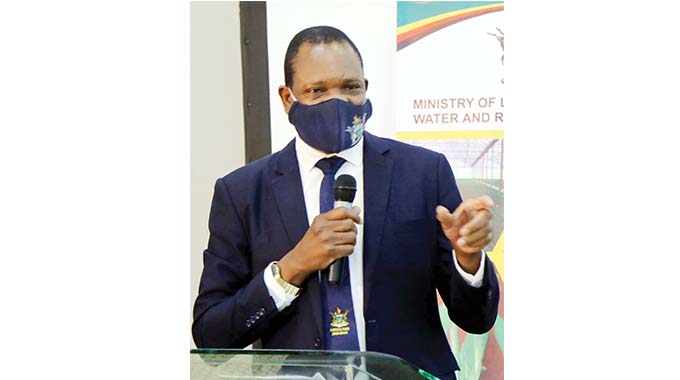
Mashudu Netsianda, Senior Reporter
GOVERNMENT has identified a vast track of irrigable land covering 10 000 hectares along the Gwayi-Shangani-Bulawayo pipeline and localised the construction of the pipeline resulting in cutting the initial estimated cost of $1, 2 billion by more than 60 percent.
The Gwayi-Shangani Dam project, which is part of the National Matabeleland Zambezi Water Project (NMZWP), is set to be completed by December this year while the 245km pipeline that connects the dam to Bulawayo will be completed in 2022.
The Second Republic under President Mnangagwa has stepped up efforts to fulfil the century-old dream to permanently solve Bulawayo’s perennial water woes as well as transform lives in the Matabeleland region.
The President last Thursday officiated at the ground breaking ceremony of the Gwayi-Shangani pipeline and commissioned the Epping Forest water project in Nyamandlovu under Umguza District in Matabeleland North.
Speaking during the event, Lands, Agriculture, Fisheries, Water and Rural Resettlement Minister Anxious Jongwe Masuka said his ministry has identified 10 000 hectares of land along the Gwayi-Shangani to Bulawayo pipeline, which will be utilised for irrigation purposes.
“We have identified about 10 000 hectares of land that can be irrigated using water from the Gwayi-Shangani Dam while still providing 450ML of water per day to Bulawayo residents, which is three times what the city requires,” he said.
“This landmark project could not have been accomplished without the support of various stakeholders.
“Treasury has indicated that it is going to provide additional resources to the tune of $535 million for feasibility studies to enable the Ministry to deliver service.”
Minister Masuka said the original cost for the Gwayi-Shangani-Bulawayo pipeline was estimated at $1,2 billion, but through discussion with Zimbabwe National Water Authority (Zinwa), the construction of the project has been localised thus reducing the cost by more than 60 percent.
“We therefore envisage that this project will now cost us in the region of between $500 million and $600 million at most including the ancillary irrigation works. My Ministry is indeed humbled by the Government’s continued support,” he said.
“On 16 November last year, the President approved that Zinwa undertakes two critical major projects for two urban centres and first for the city of Bulawayo being the Gwayi-Shangani-Bulawayo pipeline, secondly that Zinwa undertakes Kunzvi Dam construction in Goromonzi district in Mashonland East province.”
Minister Masuka said he was confident that through the ongoing water projects, the country is set to move forward and achieve Vision 2030.

Dr Anxious Masuka
“The augmentation of the water supply in Bulawayo is a stop gap measure while we bring in the long-term solution which is the pipeline. It is going to be life changing for communities through which it passes. On 23 December 2022, residents of Bulawayo will be able to open a tap that delivers water from Gwayi-Shangani Dam. This is one of the hallmarks of the Second Republic and wise leadership of President Mnangagwa,” he said.
In an interview yesterday, Matabeleland North Provincial Affairs and Devolution Minister Richard Moyo said the envisaged greenbelt along the pipeline will generate employment and boost food security in the largely rural province.
“This project will guarantee food security for our province as there will be increased farming activities. Communities in Hwange and Lupane will also benefit in terms of employment and our gross domestic product as a province will increase,” he said.
Bulawayo mayor Councillor Solomon Mguni said the increased farming activities along the Gwayi-Shangani-Bulawayo pipeline will boost the city’s industrial growth and help reduce the crime rate.
“In terms of the food processing sector, in Bulawayo, its not a key industry, so to us this project will add one of the key industries in terms of the food supply value chain if the greenbelt comes to fruition. We are also looking at the issue of rural-to-urban migration and therefore if employment in the agricultural sector is created within Bulawayo’s surrounding areas, it will help decongest the city,” he said.
“Lately, we have been witnessing a surge in crime rate, particularly during the lockdown, so if employment is created for youths, they will stop engaging in criminal activities.”
Consistent with the thrust to pursue Vision 2030, an additional $172 million has been allocated for the upgrading of 17 water supply schemes across the country.
Other water investments in Matabeleland North include the Binga water treatment plant commissioned last year and 180 hectares Bubi-Lupane irrigation scheme in Lupane, which is at an advanced stage.
All these developments were ushered in under the Second Republic as part of efforts to turn around the province’s socio-economy.
To improve access to water supply in rural areas, in the 2021 national budget, Government allocated $262 million to Zinwa for the drilling of boreholes.
Treasury also allocated the District Development Fund (DDF) $328 million for the procurement of 10 drilling rigs for boreholes. Government has also committed another $391 million to support DDF and Zinwa borehole drilling. — @mashnets
